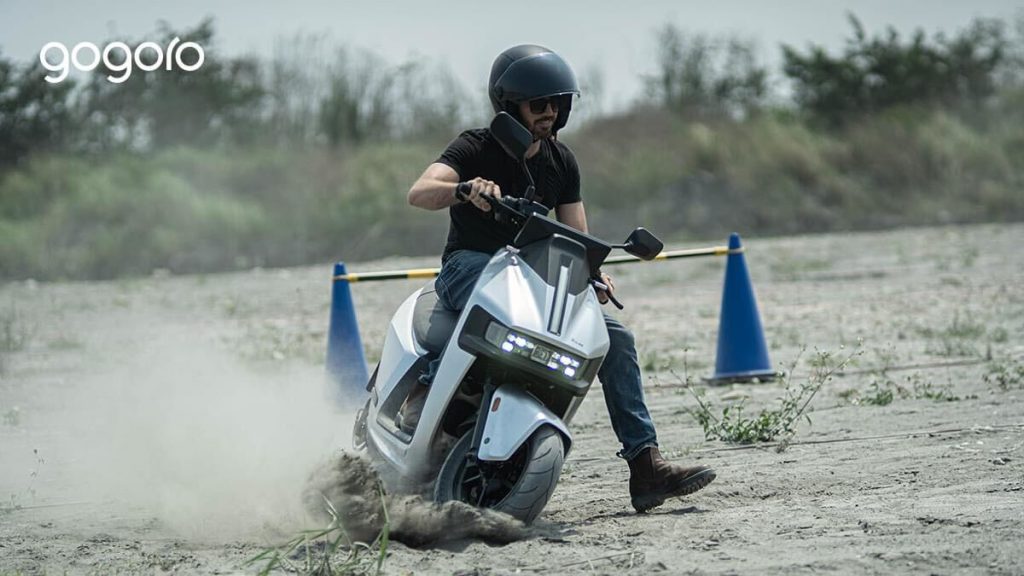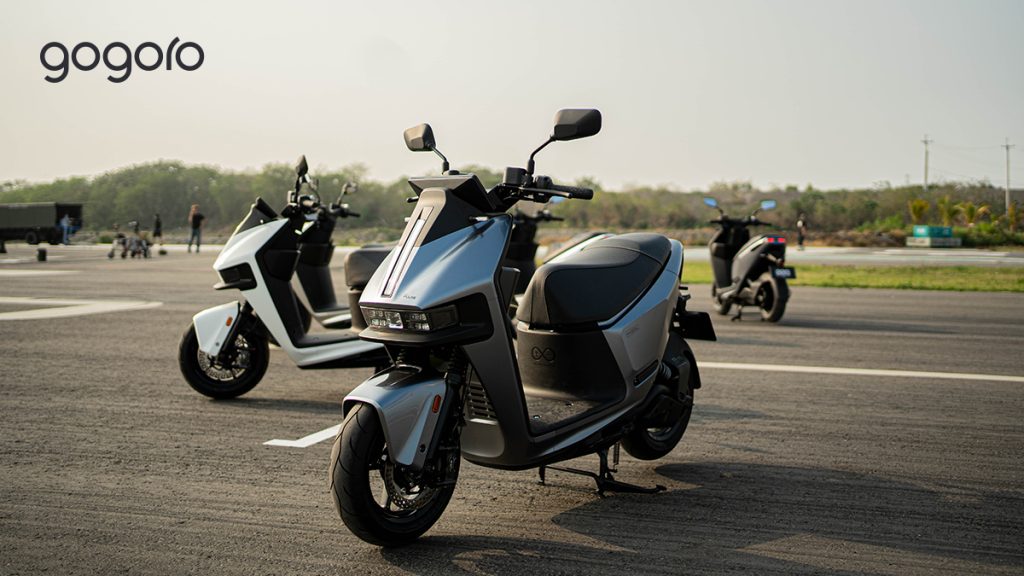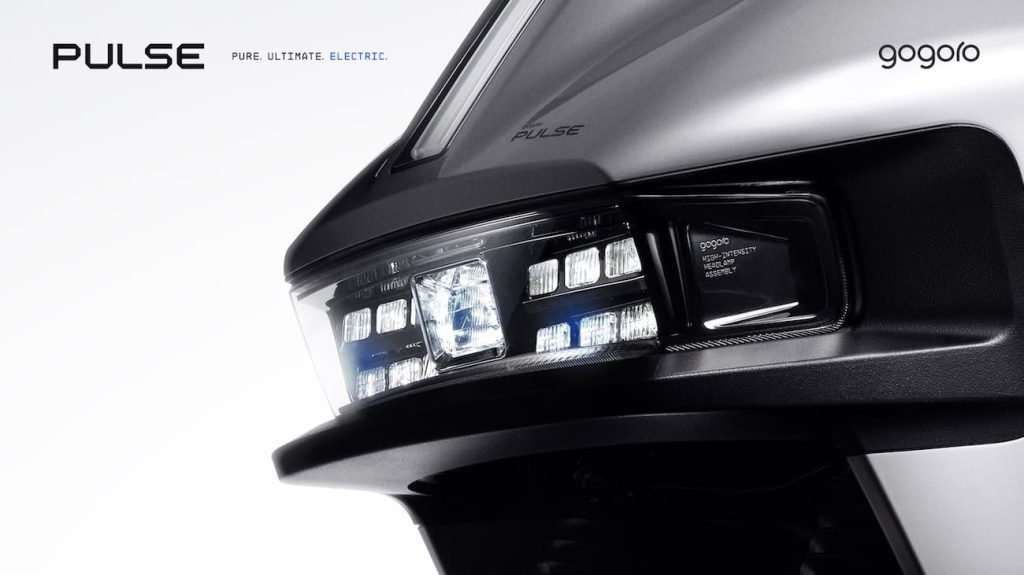
When Gogoro rolled out its new high-performance electric scooter, the Pulse, the world got its first glimpse of an entirely new side of the company. Best known for its battery-swapping system and cute, brightly-colored scooters, the Pulse launched an edgy new look for Gogoro. But even more importantly, it also showed off an entire suite of new high-tech innovations.
And so when I received an invite to be the first Westerner to test ride the Pulse and share the experience with the world, I jumped on it. Every company seems to proclaim that their new e-scooter is like none other before, but only the Gogoro Pulse is one of the few that can truly mean it. This electric scooter marks a paradigm shift in what is possible for this form factor and with Gogoro’s swappable battery standard.
Gogoro Pulse First Ride Video
To get a sense of what it’s like to throw a leg over this scooter, check out my video below.
But don’t forget to keep reading afterward, for all of the fun details!
I arrived early in the morning at a nondescript, largely abandoned airstrip in central Taiwan. There weren’t any planes on the tarmac, but lined up at the end of the single runway was something that looked just as fast and aerodynamic – the Gogoro Pulse electric scooter.
In fact, there were around a dozen of the silvery, angular scooters. Lined up shoulder to shoulder, they beckoned for an afternoon of fun. I soon found myself shoulder to shoulder as well, though it was with around 40 local journalists, all as eager as I was to get a first ride on the powerful, techie new electric two-wheeler. There was so much shared excitement in the air, I almost didn’t notice the “one of these things isn’t like the other” moment I was having, at least until the Mandarin started flying.
After a short safety briefing (that I thankfully had a translator for, thanks Cameron!) and a chance to gear up, we were off to the races. Literally. There was a drag strip set up as one of several testing stations, making full use of the short runway to test the most powerful mode on the scooter: Launch Mode. It unlocks every last watt available from the 9 kW-rated powertrain, letting riders absolutely fly off the starting line. But more on that in a moment.

First, I got to test out the traction control. In a sandy area off to the side of the airstrip, a coned-off section of loose sand and dust made for the perfect (i.e., worst) conditions. The scooter comes with a specially designed Dirt Mode meant to help keep traction on loose surfaces like this. It relies on the company’s new Hypercore, a powerful smart system that delivers state-of-the-art traction control.
I’m not much of a dirt rider myself, and you’re more likely to find me riding elbow distance between two delivery trucks than hugging the berms on trails. But I still did my best to get the scooter sideways.
Even in that loose and silty soil, each time I felt the rear starting to fishtail, the traction control helped me bring it back and keep the rubber side down. I was sure I would lose it a few times, but somehow the Pulse seemed to anticipate my pending disaster in the turns and take care of the hard parts for me.

From there, I moved to the slalom course, which was a series of cones set up on the angle strip. Gogoro’s pro rider showed me a demo first, in which he rode so fast and cornered so hard through the slalom that he dragged the edge of the side stand more than once. I certainly wasn’t about to push it that hard and leave bits of steel on the asphalt, but I still enjoyed pushing the scooter through the course and feeling how easy it was to flick back and forth.
Of course, the main event was that Launch Mode demonstration, where I got to line back up on the main strip with a set of Christmas tree lights counting me down for good measure.
To enable this ultra-fast takeoff program, you have to initiate launch mode with a video game-style series of secret inputs, the last of which includes holding in the rear brake lever like a clutch. If you put the cheat code in successfully, you’ll get the prompt and the scooter will literally start shaking. It’s actually just the mid-mounted motor cleverly rocking itself to create the simulation of a high-revving engine ready to pop the clutch. And to launch, that’s exactly what you do – except that the clutch is really the rear brake lever, and releasing it sends you flying down the road at peak acceleration. It’s hard to explain what 378 Nm (279 lb-ft) of torque at the rear wheel feels like, but I definitely saw another journalist almost slip off the back of the scooter when he wasn’t expecting the acceleration to be so punchy.
I only had 250 meters (820 feet) before the “STOP” section of the course began, but I was already into the triple digits on the speedometer, which converting km/h into mph means I had just surpassed 62 mph before having to quickly engage the brakes as the end of the course neared.

Each test was designed to show off another aspect of the Gogoro’s Pulse performance, from the traction control to the maneuverability and finally the insane power that can be unleashed by those brave enough to demand it.
But what’s perhaps even more impressive isn’t the groundbreaking performance but rather the technology that ties it all together.
The Gogoro Pulse shares several features that sound more at home on new sports cars than on an electric scooter. The scooter’s Smart Cockpit dashboard is built around a massive 10.25-inch panoramic HD touch display that integrates with Gogoro’s iQ Touch HD user interface. The new iQ Touch HD system offers a variety of new features and services, including different ride modes, turn-by-turn GPS navigation with real-time traffic information, and Gogoro GoStation locations for quick and convenient battery swaps. Fortunately, I was glad to see that there are still easy-to-use push-button controls and dials. Touch screens are nice for something things, but I’ll never want to give up the tactile feedback of real buttons and knobs. The mode selector is an oversized and generously knurled physical knob, which makes you feel like you’re selecting functions in a fighter jet cockpit. Now THAT’S a knob!

I’m glad to hear that turn-by-turn GPS navigation will be available on the screen, though that feature wasn’t quite finished during our testing. I can picture in my head what a map looks like on a giant screen though, so I’m just glad to hear it’s coming. That also means I don’t need to keep my phone on the handlebars anymore when I want to use a nav app – I can just let the scooter’s massive display handle it for me.
Gogoro’s Smart Cockpit also makes the Pulse the first two-wheel vehicle in the world to be powered by Qualcomm’s new Snapdragon QWM2290 digital chassis. Again, this is stuff that has no business being on a two-wheeler, at least not until Gogoro decided that riders shouldn’t have to take a backseat to drivers anymore in the technology department.
And then there’s the headlight. Or I guess I should say, headlights. An array of 13 individual LED units fire on and off dynamically depending on riding conditions, helping to throw the beam closer or further depending on speed, as well as angling the light around curves when necessary, all without any physically moving parts.

And while I didn’t actually test this part out during the test riding since you just can’t go very far within the confines of an airstrip, the scooters obviously make use of Gogoro’s world-famous battery-swapping standard.
That means you get the benefits of Gogoro’s recognizable bright green batteries that are spread all over the markets where Gogoro operates. In Tapei, riders are never more than a few hundred meters from a battery-swapping station. Across the island, thousands of stations perform hundreds of thousands of battery swaps daily.
And now Gogoro is in more countries across Asia than I can keep track of anymore. The options are growing seemingly every month.
The beauty of this battery-swapping system is that range simply doesn’t matter anymore. Who cares if the scooter can get 50 km or 150 km of range? It doesn’t really matter since, in both situations, you’ll probably pass 100 different battery-swapping stations during that time.

So as you can see, this isn’t just a high-performance electric scooter. It’s also a high tech vehicle that takes advantage of much of the tech we generally associate with luxury cars, but has now been brought to us as riders.
Having ridden around Taipei recently, I can tell you that this is probably more scooter than many people will need. It’s just so much power and performance that it’s the equivalent of a sports car in a city. But then again, sports cars are fun for the simple fact that they’re fun, so even locked in a city, the Pulse would be a blast. But once you can get out onto some faster roads and really open it up, that’s where the scooter will come alive.
If staying in a city, that Launch Mode can still be fun, but I don’t think many people need to fly off as quickly as this scooter can each time the light turns green. But what it does do is give riders the opportunity to do more with their ride. The same bike that serves as a weekly commuter can also be a fun weekend performance ride up and down twisting mountain roads. It can take you offroad and onto the trails, knowing full well that traction control is there to back you up. And it can enable safer riding with GPS navigation front and center where you need it and lighting that predicts your turns to illuminate the curves ahead of you.
That’s pretty darn impressive for an electric scooter, if you ask me!
FTC: We use income earning auto affiliate links. More.





Comments